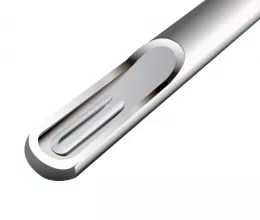There are many different types of thermometers for industrial applications, with different working principles and uses. Follow us to learn about these principles and types of thermometers.
1. Glass Thermometer
Glass thermometers have a simple structure and low cost. Not only common in daily life, you will find these are also widely used in industrial applications. However, glass thermometers have some disadvantages. They can be fragile, so they need to be used with care. Because glass refracts light, a slight deviation in viewing angle can lead to inaccurate readings. Suitable for use in chemical experimental products. The typical temperature ranges are -60°C to 200°C.
Working principle:
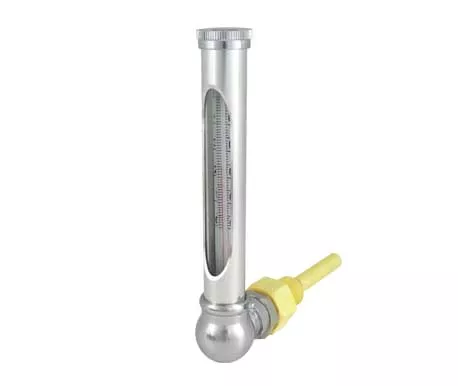 |
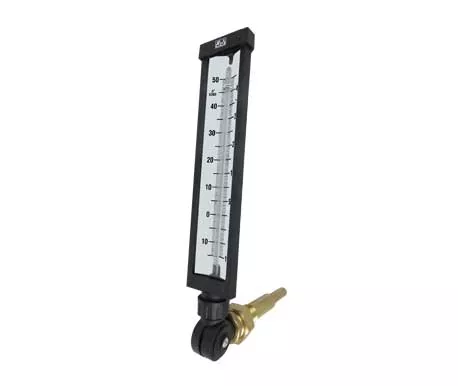 |
|
Diesel Glass Thermometer |
V-line Thermometer |
Liquid is injected inside the glass capillary and bulb. Temperature is measured by the principle of thermal expansion and contraction of the liquid when the temperature changes.
2. Bimetal Thermometer
The biggest strength of bimetal thermometers is that the change in the ambient temperature does not affect the measurement result through an offset or jitter pointer. Bimetal thermometers have to wait for the metal inside to expand to measure the temperature, so the response time is slower. Stainless steel is suitable for use outdoors and in other places. The typical temperature range is -70°C to 600°C.
Working principle:
 |
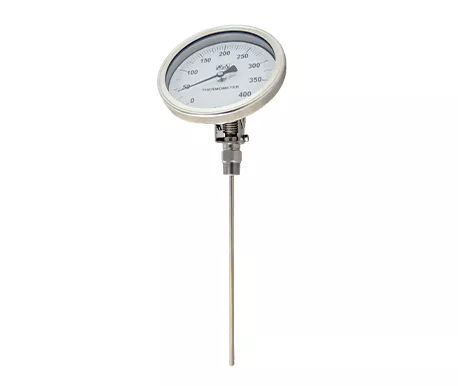 |
|
Bimetallic Thermometer Bottom Mount |
Bimetallic Thermometer Adjustable Angle |
Two different sheets of metal are bonded together and made into a spiral shape, and the temperature is measured by the different characteristics of the metal expansion coefficient. Fix one end of the bimetallic spiral to the fixed end and the other end to the pointer. When the temperature changes, the metal sheet will expand or contract to metal bending, driving the pointer to rotate.
3. Gas Expansion Thermometer
Gas expansion thermometers can display temperature changes instantaneously, and can achieve long-distance (up to 60 m) temperature measurement via a capillary tube. They are suitable for precision measurements and other applications. The disadvantage is that the gas will be affected by the ambient temperature, so the change in the ambient temperature will cause the pointer to shake or shift. The typical temperature ranges are -200°C to 700°C.
Working principle:
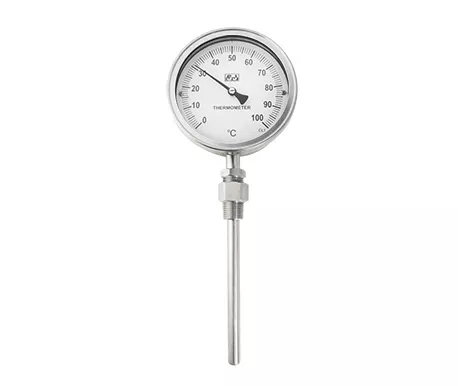 |
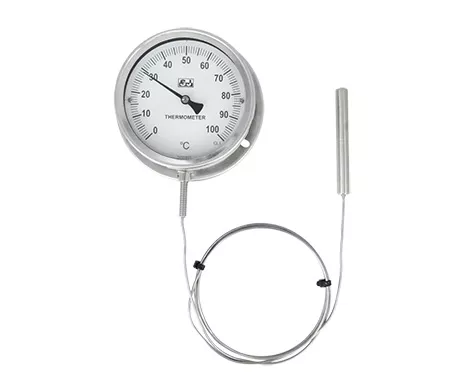 |
|
Expansion Thermometer |
Capillary Expansion Thermometer |
The principle of gas expansion thermometers is to use gas to measure temperature. Gas is injected into the capillary, and when the temperature changes, the gas pressure in the tube will change. The pressure causes the Bourdon tube to deform and drive the pointer to display the temperature.
4. Thermocouple Thermometer
Thermocouple thermometers have high accuracy and a large measurement range. The output signal is stable, so they are often used in industrial automation. However, signal conditioning in the reading range takes a lot of time and complexity, so they are not suitable for measuring small temperature changes. They are more prone to corrosion and abrasion, so they need protective equipment to extend their life. The typical temperature range is -200°C to 2500°C (different conductor materials, different temperature ranges).
Working principle:
Thermocouple Thermometer
The main principle of thermocouple thermometers is the thermoelectric effect, which consists of two metal conductors of different properties to form a circuit, so that the temperature at the node of the two metals is different. The resulting temperature difference will generate a thermoelectric motive force, producing a measurable voltage to measure the temperature. When the material of the metal at both ends is determined, the magnitude of the thermoelectric motive force is related to the temperature difference at the two nodes. Two ends are used — the measuring end and the reference (or fixed) end. The reference end is usually set at 0°C.
5. Resistance Thermometer (RTD)
Resistance thermometers (RTD) are resistant to high temperatures and have a large measurement range. They have long-lasting, high stability and are widely used in applications with high temperature detection such as metal processing, power, refining, and other industries. However, they are more susceptible to corrosion, have a low melting point, and must be maintained in a dry environment. The typical temperature range is -200°C to 600°C.
Working principle:
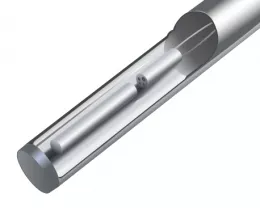
Resistance Thermometer (RTD)
The principle of resistance thermometers (RTD) is measuring resistance. By using a pure metal electrical conductor, the resistance value will change according to the temperature, thereby measuring the temperature. They are often used in high-precision applications. The most common metal is platinum (PT), which has excellent corrosion and oxidation resistance, and high induction and stability. Pt100 is the most widely used.
After reading about these five industrial thermometers, do you have a better understanding of the thermometer that is suitable for you? Click the link below to read more to learn more about thermometers!



